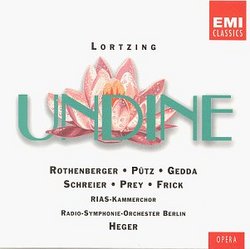| All Artists: Albert Lortzing, Radio-Symphonie-Orchester Berlin, RIAS-Kammerchor Robert Heger, Ruth-Margaret Pütz, Nicolai Gedda, Peter Schreier Anneliese Rothenberger Title: Lortzing - Undine / Rothenberger ˇ Pütz ˇ Gedda ˇ Schreier ˇ Hermann Prey ˇ Gottlob Frick ˇ Heger Members Wishing: 0 Total Copies: 0 Label: Angel Records Release Date: 1/12/1993 Album Type: Import Genre: Classical Style: Opera & Classical Vocal Number of Discs: 2 SwapaCD Credits: 2 UPC: 077776320823 |
Search - Albert Lortzing, Radio-Symphonie-Orchester Berlin, RIAS-Kammerchor Robert Heger, Ruth-Margaret Pütz, Nicolai Gedda, Peter Schreier Anneliese Rothenberger :: Lortzing - Undine / Rothenberger ˇ Pütz ˇ Gedda ˇ Schreier ˇ Hermann Prey ˇ Gottlob Frick ˇ Heger
 | Albert Lortzing, Radio-Symphonie-Orchester Berlin, RIAS-Kammerchor Robert Heger, Ruth-Margaret Pütz, Nicolai Gedda, Peter Schreier Anneliese Rothenberger Lortzing - Undine / Rothenberger ˇ Pütz ˇ Gedda ˇ Schreier ˇ Hermann Prey ˇ Gottlob Frick ˇ Heger Genre: Classical
|
Larger Image |
CD Details |
CD ReviewsA Mendelssohnian Opera John D. Pilkey | Santa Clarita, CA USA | 10/01/2006 (5 out of 5 stars) "Friedrich de la Motte-Fouque's Undine (1711) is one of the best German romances. It combines fairy tale supernaturalism, German local color at the Upper Danube, wholesome piety, veneration for the newly defunct Holy Roman Empire and a unique love triangle. Lortzing's 1845 opera differs considerably both from the romance and author-composer E. T. A. Hoffmann's 1816 opera version. It is more polished than Hoffmann's work but also more comic and less romantic. Lortzing fails, for example, to reproduce the sublime, anti-social threat posed by Undine's water sprite uncle Kuhleborn. He adds comic characters who change the atmosphere of the original romance. It is true that Hoffmann's tales and other German romances feature humor; but the romance Undine, despite being colorful and sometimes light-hearted, is essentially serious. Undine's transformation from a soulless water sprite into a loving wife with a soul is a serious matter. Lortzing's opera is more sophisticated, brilliant and morally superficial than the original Undine tradition.
Born the same year as Bellini in 1801, Lortzing put in time as an actor; and it shows. His Undine is theatrical light opera. Ewen notes that "Lortzing's lovely melodies are more strongly influenced [in Undine] by Mendelssohn than by Weber." Weber had, in fact, taken up the romantic suggestion of anti-social Kuhleborn and converted it into his dire characters Caspar and Samiel. Ewen concludes, "Lortzing's sunny nature was reflected in his music." A duet between Veit and Hans early in Act II establishes a comic atmosphere that is more than just comic relief. Neither character has anything to do with the original romance. Veit, in fact, takes the first aria of the opera and then is used to sketch the central features of the tale in a spoken dialogue. He does so after saying, "Here I'm a cook, butler and shoemaker-- all in one!" We think we are listening to Figaro or Leporello. In the romance Undine is flighty and wayward because of her soulless condition; but here Lortzing presents her as rejoicing at life like a normal young woman: "Ah, what joy, what elation! / The beloved sun shines brightly/ on village meadows again!" Instead of running loose as she does at the outset of the romance and the 1816 opera, she has already called in a priest to marry her to the knight Hugo von Ringstretten (Nicolai Gedda). Civilized norms are in control of Lortzing's version of the story." |

 Track Listings (13) - Disc #1
Track Listings (13) - Disc #1